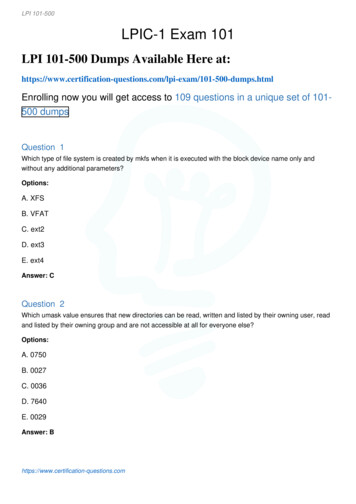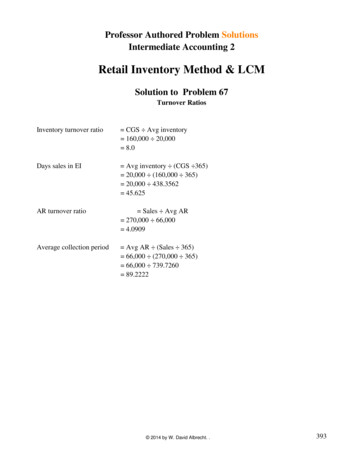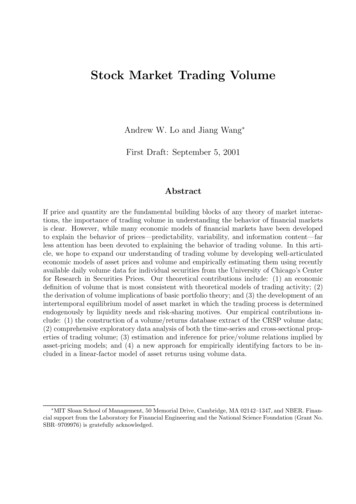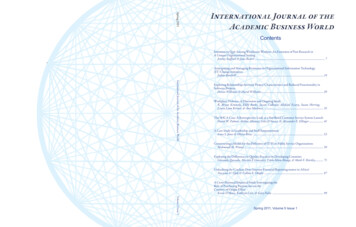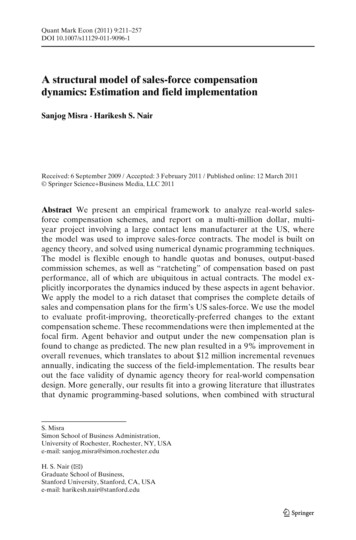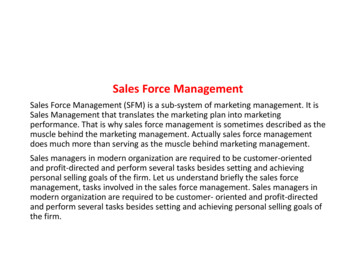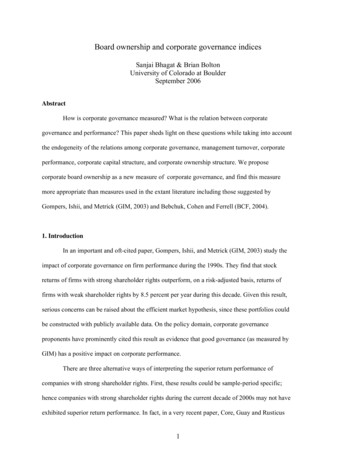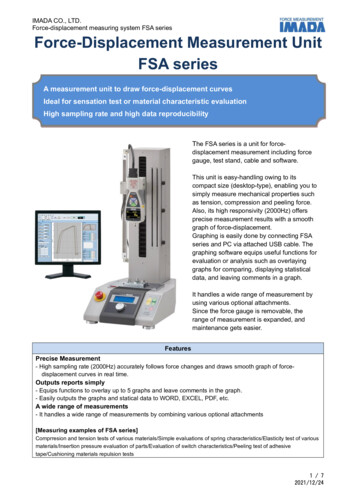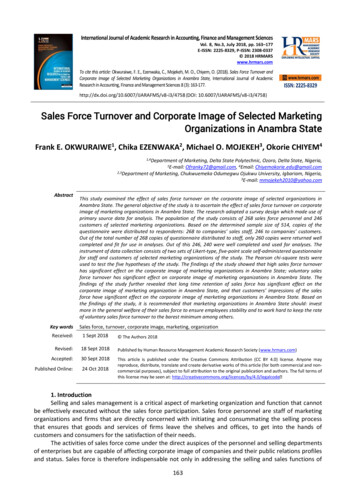
Transcription
International Journal of Academic Research in Accounting, Finance and Management SciencesVol. 8, No.3, July 2018, pp. 163–177E-ISSN: 2225-8329, P-ISSN: 2308-0337 2018 HRMARSwww.hrmars.comTo cite this article: Okwuraiwe, F. E., Ezenwaka, C., Mojekeh, M. O., Chiyem, O. (2018). Sales Force Turnover andCorporate Image of Selected Marketing Organizations in Anambra State, International Journal of AcademicResearch in Accounting, Finance and Management Sciences 8 (3): 758 (DOI: 10.6007/IJARAFMS/v8-i3/4758)Sales Force Turnover and Corporate Image of Selected MarketingOrganizations in Anambra StateFrank E. OKWURAIWE1, Chika EZENWAKA2, Michael O. MOJEKEH3, Okorie CHIYEM41,4Departmentof Marketing, Delta State Polytechnic, Ozoro, Delta State, Nigeria,Ofranky72@gmail.com, 4Email: Chiyemokorie.edu@gmail.com2,3Department of Marketing, Chukwuemeka Odumegwu Ojukwu University, Igbariam, Nigeria,3E-mail: mmojekeh2010@yahoo.com1E-mail:AbstractKey wordsThis study examined the effect of sales force turnover on the corporate image of selected organizations inAnambra State. The general objective of the study is to ascertain the effect of sales force turnover on corporateimage of marketing organizations in Anambra State. The research adopted a survey design which made use ofprimary source data for analysis. The population of the study consists of 268 sales force personnel and 246customers of selected marketing organizations. Based on the determined sample size of 514, copies of thequestionnaire were distributed to respondents: 268 to companies’ sales staff, 246 to companies’ customers.Out of the total number of 268 copies of questionnaire distributed to staff, only 260 copies were returned wellcompleted and fit for use in analyses. Out of this 246, 240 were well completed and used for analyses. Theinstrument of data collection consists of two sets of Likert-type, five-point scale self-administered questionnairefor staff and customers of selected marketing organizations of the study. The Pearson chi-square tests wereused to test the five hypotheses of the study. The findings of the study showed that high sales force turnoverhas significant effect on the corporate image of marketing organizations in Anambra State; voluntary salesforce turnover has significant effect on corporate image of marketing organizations in Anambra State. Thefindings of the study further revealed that long time retention of sales force has significant effect on thecorporate image of marketing organization in Anambra State, and that customers’ impressions of the salesforce have significant effect on the corporate image of marketing organizations in Anambra State. Based onthe findings of the study, it is recommended that marketing organizations in Anambra State should: investmore in the general welfare of their sales force to ensure employees stability and to work hard to keep the rateof voluntary sales force turnover to the barest minimum among others.Sales force, turnover, corporate image, marketing, organizationReceived:1 Sept 2018 The Authors 2018Revised:18 Sept 2018Published by Human Resource Management Academic Research Society (www.hrmars.com)Accepted:30 Sept 2018Published Online:24 Oct 2018This article is published under the Creative Commons Attribution (CC BY 4.0) license. Anyone mayreproduce, distribute, translate and create derivative works of this article (for both commercial and noncommercial purposes), subject to full attribution to the original publication and authors. The full terms ofthis license may be seen at: de1. IntroductionSelling and sales management is a critical aspect of marketing organization and function that cannotbe effectively executed without the sales force participation. Sales force personnel are staff of marketingorganizations and firms that are directly concerned with initiating and consummating the selling processthat ensures that goods and services of firms leave the shelves and offices, to get into the hands ofcustomers and consumers for the satisfaction of their needs.The activities of sales force come under the direct auspices of the personnel and selling departmentsof enterprises but are capable of affecting corporate image of companies and their public relations profilesand status. Sales force is therefore indispensable not only in addressing the selling and sales functions of163
International Journal of Academic Research in Accounting, Finance and Management SciencesVol. 8 (3), pp. 163–177, 2018 HRMARS (www.hrmars.com)companies and organizations but also in addressing their public relations challenges, which is the focus areaof the study.Osho (2010) states that public relations is an organization’s effort to win the co-operation of groupsof people that help an organization and its public, to adapt mutually to each other. Public-relations are allabout the management of relationships through the tools of communication to build goodwill and harmonybetween an organization and its publics. It concerns itself with the public perceptions, expectations,opinion and attitudes, so that they may think well and act positively towards an organization.Sales force remains one of the most productive resources available to a company. This is becausesales force enacts sales that lead to the solvency and profitability of the company. Sales force is acomponent of the human resource capital of an organization that specialized in the selling of goods andservices of that organization. They are employees of companies saddled with the field work of reaching outto various customer segments of these companies. In the face of increasingly challenging competitivenessand economic recession, the role of sales force employees in an enterprise, gains more weight and valuethan before, thus becoming the solution to the success of many companies. Arguably, this is the reasonwhy managers and researchers have been showing long standing interest in identifying the conditions thatpromote employee job performance (Hui et al., 2007). Extant research has shown that employee intentionregarding turnover has been considered to be an important antecedent to individual job performance(Palich et al., 1995). The implication of this is that sales force turnover intention or rate could affectindividual staff performance, which in turn would affect firm’s profitability and/or image or reputation.Again, the strength or number of sales force can also affect sales as well as individual sales forceperformance. Thus, when sales force performance is increased, sales almost always increase (Tariq et al.,2013; Odetoyinbo, 2010). This is in the believe, that the more satisfied the sales force of a firm , everythingbeing equal, the more the sales (in terms of quantity and revenue) it could make. This suggests that firmsshould keep on increasing the size of their sales force and not perchance, increasingly reducing the salesforce. It is therefore expected that a company should maintain a reasonable and sizeable number of salespersons at its disposal, at a relatively stable rate, to gain good corporate image, maintain high marketshare, and increase sales volume and profitability. The front-line role of the sales force means that formany customers, the sales force is the company (Jobber and Lancaster, 2006).Corporate image describes the manner in which a company or organization, its activities, and itsproducts or services, are perceived by its various publics. It is about how a company or firm is perceived inthe eyes of the general public and the image the company portrays. Employees of organizations are firstand foremost, the most important publics of an organization often referred to in marketing as theorganization’s internal customers. The employees of an organization can affect the company’s reputationor image. Employees who have a positive or negative work experience share it. Thus, attitudes of acompany’s employees often influence how it is perceived by its clients or external customers. As observedby Osho (2010) the reputation of an organization runs down easily if the workers are poorly paid, and badlytreated. In fact, it is a matter of time, for such an organization to run into serious problem, total breakdownor staff always complaining. These are great hackers of corporate reputation ultimately; this will affect theproduction of the organization, the quality of its products and services, market shares will dwindle, theprofitability will nosedive drastically, which may lead to total breakdown and closure of the establishment.Good corporate image should be craved for by every well-meaning company and the sales forcecould be final ambassadors of the company as they relate with the company's customers and the public atlarge. Image is generally a kind of unique, personal perception, state or position an individual or group hascreated or carved for itself. It can be "good" or "bad" as people usually referred to (Odetoyinbo, 2010).Thus, corporate image is here defined as the general opinion which a company creates for itself, with theview to gaining the positive disposition of its publics towards itself, products and services as well as, theperception which the various publics of the company hold about the company. In as much as it has beenstrongly suggested by past studies (Tariq et al., 2013; Osho, 2010) that increasing the sales force couldincrease sales volume and market share of business organizations, incessant sales force turnover couldpresumably affect the firms’ image and performance negatively. It is being argued that high rate of salesforce turnover could therefore lead to low sales and even firm's collapse.164
International Journal of Academic Research in Accounting, Finance and Management SciencesVol. 8 (3), pp. 163–177, 2018 HRMARS (www.hrmars.com)1.1. Statement of the ProblemAs companies frontline employees, sales force staff are often regarded by many customers as thereflection of the company (Jobber and Lancasters, 2006). Where sales force turnover is high, the image of acompany, as a stable and potentially successful corporate entity becomes doubtful and huge amount ofmoney need to be expended on both public relations and staff recruitment practices, owing to highemployee turnover (Nwokoye, 2005). Staff of every organization contributes to its corporate image (Osho,2010). In the same vein, the corporate image of an organization can be undermined by absenteeism, lay-offand continuous changes of jobs to other organizations (Onwuchekwa, 1995). Many recent studies exist onthe effect of labour turnover on corporate performance (see Hansknecht and Trevor, 2011; Holm, 2011;Shaw, 2011; Holtom et al.; 2008). Tariq et al. (2013) and Holm (2011) state that high workforce turnoverhave expected negative effect on corporate performance.It has been alleged that private sector business organizations in Onitsha, and it’s environ, especially,the small and medium enterprises (SMEs), are particularly prone to high rates of staff turnover andarguably impacting negatively on their corporate image. This study therefore empirically examined thephenomenon of sales force turnover dimensions, as perceived by staff and customers, and the effect on thecorporate image, sales volume and profitability of Envoy Oil Limited and Golden Oil Industries Limited, all inAnambra State.1.2. Objectives of the StudyThe general objective of this study is to ascertain the effect of sales force turnover on corporateimage of marketing organizations in Anambra State. The study specifically seeks to: assess the effect ofvoluntary sales force turnover; ascertain the effect of involuntary turnover animosity; and determine theeffect of long time retention of sale force on the corporate image of companies in Anambra State.1.3. HypothesesThe following hypotheses were tested in the study: High sales force turnover has no significant effect on corporate image of marketing organizationsin Anambra State. Voluntary sales force turnover has no significant effect on the corporate image of marketingorganizations in Anambra State. Involuntary sales force turnover animosity has no significant effect on the corporate image ofmarketing organizations in Anambra State. Long time retention of sales force has no significant effect on the corporate image of marketingorganizations in Anambra State.This study covered the effect of sales force turnover on the corporate image of Envoy Oil IndustriesLimited, Onitsha and Golden Oil Industries Limited, Onitsha and life vegetable oil, Nnewi Anambra State, forthe period between 2004 and 2014.Oil firms are chosen for the study because they make extensive use ofsales force staff that engage in personal selling and directing marketing of their finished products.2. Conceptual Framework2.1. Sales forceThe sales force is a company’s frontline staff nearest to the customers. Arguably, the ideal salesforce, the well-motivated and efficient sales staff, remains relatively long on the job and capable ofdelivering the goods and services of the company to meet the consumers’ needs satisfactorily. Ascompany’s frontline staff, they are often perceived by many customers as the reflection of the company(Jobber and Lancaster, 2006). Sales force often forge close relationships with their customers and caninfluence their decisions to buy or not to buy the company’s offerings and their turnover incur opportunitycosts to their companies. Thus, human resources professionals continually work to control their companies’employee retention and turnover rates (Butali et al., 2003). Retention is the term given to keeping loyalemployees on board with a company, while turnover refers to the rate at which a company loses existingemployees and replace them with new ones. Shaw (2011), Hausknecht and Trevor (2011) and Holton,165
International Journal of Academic Research in Accounting, Finance and Management SciencesVol. 8 (3), pp. 163–177, 2018 HRMARS (www.hrmars.com)Mitchel, Lee and Eberly (2008) in their various studies made a distinction between voluntary turnover(workers quitting their being fired). Zeynep and Huckman (2008) argue that employee turnover inorganizations has received substantial attention from both academics and managers. Much of thisattention has been focused on understanding its causes. Implicit in this approach, is the assumption thatturnover is driven by certain identifiable characteristics of workers, tasks, firms, and markets, and that, bydeveloping policies to address these characteristics, managers might reduce the occurrence of sales forceturnover in their respective organizations. Butali et al. (2013) arguing on the same line, state thatunderstanding employee retention and turnover, and how each can be used to advantage can enhance acompany’s human resources policies and build a productive workforce.Employees that stay long in organizations tend to have better job experiences; are more costeffective and more efficient on their jobs. As observed by Armstrong (2001), long-term employees generallyhave higher productivity and efficiency on the job than newer employees, due to their length of experiencewith the firm. Butali et al., (2013) state that as experienced workers are replaced by new hires, productivitycan drop dramatically. Not only are new hires very unproductive compared to experienced workers, buttrainers’ productivity drops during training periods as well.2.2. Employee TurnoverTheories concerning the effect of employee turnover on performance appear in several forms butthey all rely on the premise that when members quit an organization it loses firm specific human capitaland social capital, experiences a disruption to its routines and incurs various forms of search and trainingcosts in connection with replacement (Hemsknecht and Trevor, 2011). Although authorities differ on theeffects of turnover on organization, it is generally on performance. Zeynep and Huckman (2008) state thatseveral studies suggest that turnover decreases operating performance and that low rates of turnover arepreferable to high rates. Hom and Griffeth (1995) and Darmon (1990) emphasized on the indirect costs ofturnover. The authors argued that much of the negative effect stems from the cost of turnover, such asthose involved with severance and the recruitment and training of new employees. Firms may experienceoperational disruption following the departure of key employees (Mobley, 1982). This could be due toeither the loss of the firm-specific that resides in departing employees or the loss of the social capitalembedded in worker’s relationship with each other and the organization Dess et al., (2001). Another sourceof indirect costs is the demoralization of employees who remain with the firm Steers et al.,(1981), thisdemoralization may be due to the loss of a respected colleague or the fact that turnover require additionalwork to be absorbed by remaining employees whose capacity is already stretched (Mowday and Porteirand Steers, 1982).Turnover of sales force, whether voluntary turnover- an employee’s decision to terminate theemployment relationship with company or employer or involuntary turnover- a company’s or employer’sdecision to terminate the employment relationship with an employee (Dess and Shaw, 2001), if not wellmanaged, can affect the image of the company negatively. For many customers and other publics ofcompanies, the employees, particularly the sales force, is the company. This view of the sales force canaffect the company’s image. Osho (2008) defines image as the subconscious impression a person has of anorganization, institution or a person and such perception by the public will dictate their positive dispositionor otherwise towards the products and services of the organization or firm.2.3. Voluntary TurnoverThis is a situation whereby an employee decides to terminate the employment relationship withcompany or employer. It describes a situation where an employee had to withdraw his or her services to anorganization or company out of his or her own volition and with external pressure from the organization orcompany to do so (Dess and Shaw, 2001).2.4. Involuntary TurnoverInvoluntary turnover refers to a company’s or employer’s decision to terminate the employmentrelationship with an employee (Dess and Shaw, 2001). A situation whereby the action is not properlymanaged, it can affect the image of the company negatively. For many customers and other publics of166
International Journal of Academic Research in Accounting, Finance and Management SciencesVol. 8 (3), pp. 163–177, 2018 HRMARS (www.hrmars.com)companies, the employees, particularly the sales force, is the company. This view of the sales force canaffect the company’s image. Osho (2008) defines image as the subconscious impression a person has of anorganization, institution or a person and such perception by the public will dictate their positive dispositionor otherwise towards the products and services of the organization or firm.2.5. Corporate ImageCorporate image describes the manner in which a company or organization, its activities, and itsproducts or services, are perceived by its various publics. It is about how a company or firm is perceived inthe eyes of the general public and the image the company portrays. Employees of organizations are firstand foremost, the most important publics of an organization, often referred to in marketing as theorganization’s internal customers. The employees of an organization can affect the company’s reputationor image. Employees who have a positive or negative work experience share it. Thus, attitudes of acompany’s employees often influence how it is perceived by its clients or external customers. As observedby Osho (2010) the reputation of an organization runs down easily if the workers are poorly paid, and badlytreated. In fact, it is a matter of time, for such an organization run into serious problem, total breakdown orstaff always complaining. These are great hackers of corporate reputation ultimately; this will affect theproduction of the organization, the quality of its products and services, market shares will dwindle, theprofitability will nosedive drastically, which may lead to total breakdown and closure of the establishment.Good corporate image should be craved for by every well-meaning company and the sales forcecould be final ambassadors of the company, as they relate with the company’s customers and the public atlarge. Image is generally a kind of unique, personal perception, state or position an individual or group hascreated or craved for itself. It can be “good” or “bad” as people usually referred to (Odetoyinbo, 2010).2.6. Marketing OrganizationAn organization comes into being when:1. There are persons able to communicate with each other.2. Who are willing to contribute action.3. To accomplish a common purpose.These elements are necessary and sufficient conditions initially and they are found in all suchorganizations (Nkem and Nkem, 1999). Organizations exist to service the internal and external interests ofsocieties in which they belong. Any modern economy consists of households or consumers, businessenterprises and non-business organizations, all of which constantly interacts within the context of adynamic environment. The interaction resulting in the conception, development, production, distributionand consumption of goods and services whose major purpose is to satisfy human need (Agbonifoh et al,1998). Marketing organization therefore, is an enterprise, which adopts the marketing concept in itsstructure operations, and functions (Nkem and Nkem, 1999), harnesses human and material resources, toensure effective development, production, distribution and consumption of goods and services, for thesatisfaction of human needs.Some organizations use marketing research to achieve this; other use judgment, intuition, andmarketing theories to give themselves sense of direction (Iornem, 1990). The marketing concept entailsidentifying customers’ needs, finding a product or service to satisfy these needs, and arranging for thisproduct to be made and sold to the consumer, so that the whole operation is to the mutual benefit (profit)of both consumer and organization (Adirikaet al., 2001).3. Theoretical FrameworkThe theoretical framework of the study is rooted in the Inequity Theory of Adam (1963). The theoryis a motivational theory developed by J. Stacey Adams in the early 1960s. The theory holds that motivationcan be affected through an individual’s perception of fair treatment in the social exchanges that take placein work places when compared to other persons.The Inequity Theory proposes that a person’s motivation is based on what he or she considers fair,when compared to others. Individuals want to be compensated fairly for their contributions in their workplaces (outcomes they experienced is expected to match their inputs). A person’s beliefs in regards to what167
International Journal of Academic Research in Accounting, Finance and Management SciencesVol. 8 (3), pp. 163–177, 2018 HRMARS (www.hrmars.com)is fair and what is not fair can affect their motivation, attitudes and behaviors and can lead to turnoverwhen applied to the workplace. Inequity theory focuses on employee’s reactions to work compensation aswell as the employee’s attempt to minimize any sense of unfairness that might result. Onwuchekwa (1995)states that this motivation theory concerns psychological reactions to feelings of inequity. The authordefined inequality as feeling either under-or-over rewarded for one’s contribution relative to the rewardsof others in similar circumstances. Accordingly, individuals compare their own situations with others insimilar situations, in terms of the contributions each makes and the rewards each derives.When inequity is perceived, tension is felt in the victim and in the work environment. The greater thefeeling of inequity, the greater the drive or motivation to reduce tension. This causes the employeesconcerned to attempt several options to awards achieving equity or fairness. Effort to attain equality orfairness can result in turnover. There is no doubt that most voluntary turnover are traceable to inequity orunfair compensation, as employees tend to incline towards greener pastures in terms of bigger and/orbetter pay. The implication of the inequity theory of motivation in the work place is that employers of laborshould strive towards attaining equity in the compensation plans for employees. Lack of equity in reward toworkers can trigger off incidences of high turnover, particularly voluntary turnover; an employee’s decisionto terminate the employment relationship. A principle of the inequity theory is based on the stimulusresponse that drives the organization to move away from unfavorable stimulus or condition. The InequityTheory is linked to this study when it is considered that sales force turnover whether voluntary orinvoluntary, when considered unfair or occurs as result of injustice, is likely to lead to negativeconsequences on the corporate image and possibly, profitability of firms.3.1. Theoretical ExpositionThe theory of inequality specifies the conditions under which perceived inequality will arise andmeans by which it may be reduced or eliminated (Adams, 1981).At the heart of inequality theory has the assumption that people pursue a balance between what the“invest” in a particular relationship (e.g. time, skills, effort) and the benefits they gain from it (such asstatus, appreciation, gratitude and pay (Adams, 1965). Every relationship strives towards achieving abalance, and distortion of this balance is expected to result in negative outcomes (Faris et al., 2004).Inequality in work relationships has been shown to be associated with lack of organizational commitment,manifesting in absenteeism and turnover, employee theft and burnout.Individuals who perceived that they were not fairly treated or under rewarded will experiencedistress that may lead to certain actions to restore equity. To reverse or reduce perceived inequality theemployee may resort to reducing his own effort. Some may try to influence their co-workers inputs throughcriticisms or even sabotage. Other may wish to withdraw emotionally or physically engage in absenteeism,tenderness or even quit the job entirely resulting voluntary turnover. Arguably, every employee wants tohave an equitable exchange with the employer. Employees desire fair reward for fair labour and may resortto some negative actions to redress perceived inequity. As observed by Adams (1963), a large proportionof employment dissatisfaction, grievances, and industrial strikes appeared to result from employeeperceived wage equities.3.3. Empirical and ReviewOsho (2010) examined the role of staff as internal publics of organizations cable of influencing thecorporate image of any organization in Nigeria. The study adopted a qualitative approach in its analyses.The study explores the unique roles of staff in the public and private sectors of the economy and concludesthat staff should be trained regularly, and oriented towards sound reputation for their organizations. Thestudy further argues that staff could make or mar the corporate image or reputation of companies. Thestudy reveals that the consciousness of every staff in Reputation management is crucial for the survival andsustenance of every organization via the internal and external publics of the organizations.Javed et al. (2014) carried out a study that investigated the determinants of job satisfaction and itsimpact on employee performance and turnover Intentions. The study was conducted in the private as wellas in public sector organizations in Bahawalpur City of Pakistan. The study among others observed that jobsatisfaction or lack of it hinges on productivity, accomplishing relationship between staff and management;168
International Journal of Academic Research in Accounting, Finance and Management SciencesVol. 8 (3), pp. 163–177, 2018 HRMARS (www.hrmars.com)indeed, the success of any organization depends on staff members who enjoy their jobs and feel rewardedby their efforts. The study aims at examined the job satisfaction levels of the employees and helpedorganizations to know about the elements that influence job satisfaction.The study is a descriptive research, and self-administered questionnaire were circulated to a sampleof 200 respondents, out of which 150 copies were properly filled and returned. The results or the dataanalysis showed significant association of employee empowerment, workplace environment, job loyaltyand job performance with job satisfaction. Furthermore, the study showed a significant negativerelationship between job satisfaction and turnover intention. The findings also demonstrated that there isno significant relationship of turnover intention with employee empowerment and job performance.The study further shows that job dissatisfaction could cause employees to move away from theirjobs, search for new jobs, or change their existing job and careers. It also shows that the degree oforganizational loyalty of employee is higher when employee job satisfaction increased. The study alsoshows that job satisfaction has impact on job performance, according to the study, job performance (JP)contribute 14% to job satisfaction (JS). It shows that level of job satisfaction and motivation affect theemployee’s productivity. The higher performers demand attractive package from the employers, but jobperformance is negatively related to the turnover intention. JP contributes 9% to turnover intention but theregression result shows that performance has no significant relation with turnover intention becauseperformance (P) is greater than 0.5.The study is not without limitations. First the study considered only few factors of job satisfaction likejob performance
This study examined the effect of sales force turnover on the corporate image of selected organizations in Anambra State. The general objective of the study is to ascertain the effect of sales force turnover on corporate image of marketing organizations in Anambra State. The research adopted a survey design which made use of
